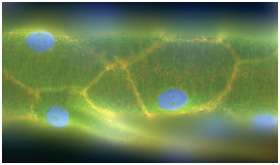Researchers Discover Communication Signal for Tissue Development

Researchers at Rensselaer Polytechnic Institute have discovered a communication signal between cells that plays an important role in cell adhesion and detachment. The finding provides new information about how cells and tissues determine when to let go from surfaces during new growth, according to the researchers.
“Our discovery of this new signaling pathway adds to fundamental information about how cells work together during the remodeling of tissues and organs,” said Andrea Page-McCaw, assistant professor of biology at Rensselaer. “This finding also may provide clues about the basic mechanisms of inflammation and wound healing in vertebrates.”
Page-McCaw’s laboratory studies the fruit fly as a model system to better understand a group of genetic enzymes called matrix metalloproteinases (MMPs). Fruit flies have two distinct MMPs, compared to 22 such enzymes found in humans and mice. In previous work, Page-McCaw found that both MMPs present in fruit flies are critical to their survival.
“Although MMP enzymes have been linked to disease progression, their normal function is to help in tissue growth and wound healing,” Page-McCaw said. “MMP research eventually could lead to therapeutics for a range of illnesses, including cancer and arthritis.”
Page-McCaw studies development and remodeling of the airway system, or tracheae, in fruit fly larvae with normal and mutant MMPs to determine how those genes contribute to normal function. In this work, she and her colleagues found that one of the MMPs chops off a piece of a protein called Ninjurin A, which is located at the surfaces of cells. The liberated piece of Ninjurin A protein then signals to other cells that it is time to detach from their surface, both in isolated cells grown in culture and in whole flies. When tracheal cells fail to detach from the insect exoskeleton, the tracheae do not grow properly and break.
The findings are currently available online in advance of print publication July 15 by the journal Genes & Development. The paper is titled “An MMP Liberates the Ninjurin A Ectodomain to Signal a Loss of Cell Adhesion.”
The research is led by Page-McCaw and includes Shuning Zhang, doctoral student at Rensselaer, and Bernadette Glasheen and Gyna Sroga, research specialists at Rensselaer. This work was initiated by Page-McCaw during her fellowship at the University of California at Berkeley, where she was assisted by Gina Dailey and Elaine Kwan.
Source: Rensselaer Polytechnic Institute

















